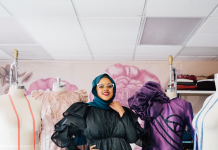 In the newly renovated second floor of the One Woodward skyscraper in downtown Detroit, a large crowd gathered in mid-October for FashionSpeak — a conference for the fashion industry put on by Detroit Garment Group Guild (DG3).
In the newly renovated second floor of the One Woodward skyscraper in downtown Detroit, a large crowd gathered in mid-October for FashionSpeak — a conference for the fashion industry put on by Detroit Garment Group Guild (DG3).
Five workshops centered on the business of fashion, and fashion designer Tracy Reese (above), who grew up in Detroit, headlined the event. Presenters emphasized the potential Detroit has to become a manufacturing mecca for the garment industry — which has been the cornerstone of DG3’s recent work.
DG3 has been working with the Detroit Economic Growth Corp. (DEGC) to find the best area for the multipurpose facility they want built by next fall.
“The dream is to grow from the DG3 multipurpose facility and allow a garment district to evolve organically,” says DG3 President Karen Buscemi.
The new facility will have a designer incubator with office space for 12 designers, who will have access to all the top industrial machinery and cutters. It will also have DG3’s new headquarters, a shop to sell local designers’ work, and a space to hold workshops, Buscemi says.
Mark Denson, DEGC’s manager of business attraction, is guiding Buscemi and her team through the process.
“The garment industry is really one of many areas we are exploring to bring manufacturing back to Detroit,” says Denson. “When people think about American made, they think about a few places. And Detroit is one of those — which is why several new companies in town have really built their own brands through the city’s revitalization.”
While there is still a lot of work to be done to establish an official garment district, Denson believes it can happen.
“Absolutely I think we can do it, but I think this is also part of a larger initiative about bringing specialized manufacturing, and manufacturing in general, back to the city,” he says.
Reese supports the idea of a garment district and thinks it’s time for Detroit, but made a point to note that if the city wants to have its own garment district, it needs to appeal to the larger market, too.
“The lion’s share of design companies are based in New York or Los Angeles and then there are smaller companies that are in Philadelphia, and now Detroit,” Reese says. “I think Detroit would need to appeal to some of the fashion-based companies in New York and L.A., and say ‘Hey, we can manufacture here as well.’ You want to reach a national audience — appealing to larger companies that are based in big fashion capitals is an important part of that.”
It seems as though Detroit received a bit more notice from the fashion world in 2014. Michigan native John Varvatos, a men’s luxury fashion designer, announced he’ll open a shop on Woodward Avenue in Detroit early next year. Over the summer, famed fashion photographer Bruce Weber, Vogue Editor-in-Chief Anna Wintour, and a number of other fashion editors flew into town from New York to visit the Detroit Institute of Arts for the launch of Weber’s exhibit featuring images he took in the city.
And the leader of the pack, Shinola — which has identified itself strongly as Detroit’s “it” brand for watches, leather goods, and bikes — opened up a shop called Willys Detroit, featuring other American-made brands.
Shinola also partnered with the College for Creative Studies to launch a new fashion accessories design program next fall.
“Two years ago if you would’ve told me all this was going to happen, I would’ve said, ‘no way,’ ” says Mark D’Andreta, DG3 vice president and the president of TD Industrial Coverings, a company that designs, manufactures, and sells custom-sewn products and apparel.
DG3 conducted a survey to find out more about the state’s demand for industrial sewers and discovered there are more than 300 vacant positions available, D’Andreta says.
And the potential jobs are not all in high-end fashion. There are numerous opportunities in industries such as automotive and furniture.
“In my business, we’ve got over 10 positions open right now that we can’t fill,” D’Andreta says. “There aren’t enough skilled sewers.”
DG3 and The Makers Coalition are doing something about that. The Detroit chapter of the coalition includes DG3, Henry Ford College Michigan Technical Education Center, the Southeast Michigan Community Alliance (SEMCA Michigan Works!), Lear Corp., and other local employers.
In October they launched Michigan’s first industrial sewing certificate program, working closely with Michigan Works! to target the unemployed or underemployed. Once students complete the program they can earn between $10-$16 per hour.
“We’ve lost the idea that learning a trade, building, and working with your hands … that you can make a living and you can have a great career,” D’Andreta says. “We can’t [forget] that skilled trades are important, and in order to bring manufacturing to Detroit, especially in the cut and sew industry, we need a skilled workforce.”
|
|
|









